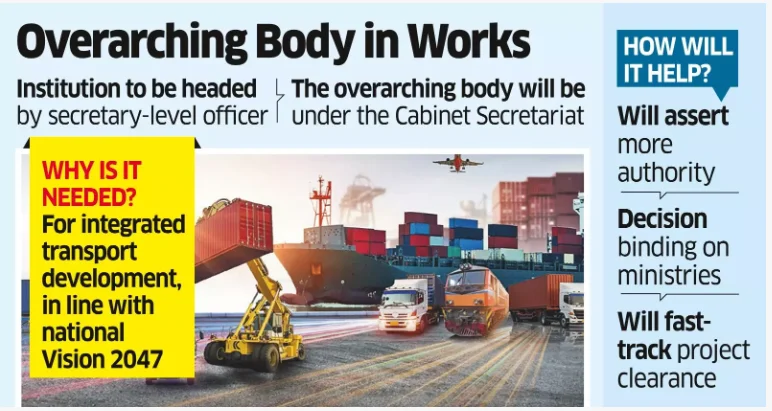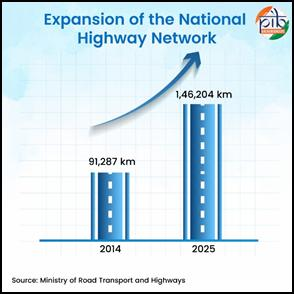Gati Shakti Transport Planning and Research Organisation (GTPRO) | 12 Nov 2025
Why in News?
The Central Government is planning to restructure the PM Gati Shakti governance framework by dissolving the existing Network Planning Group (NPG) and establishing a new high-level body, the Gati Shakti Transport Planning and Research Organisation (GTPRO).
- The NPG, established under DPIIT to coordinate inter-ministerial projects within the PM Gati Shakti National Master Plan, faced several internal challenges.
What is GatiShakti Transport Planning and Research Organisation(GTPRO)?
- About: The Integrated Transport Planning Authority, likely named Gati Shakti Transport Planning and Research Organisation (GTPRO), will create medium- to long-term roadmaps for each transport ministry, including roads, railways, shipping, and aviation.
- It will develop integrated 5- and 10-year plans, aligning with India’s goal to create world-class infrastructure and become a developed nation by 2047.
- Structure: Headed by a Cabinet Secretary.
- Functions:
- Project Appraisal: Review and approve transport sector projects valued above ₹500 crore.
- Monitoring & Evaluation: Track project progress and assess economic and environmental outcomes.
- Data Repository: Maintain a unified national database to support future infrastructure planning.
- Policy Research: Recommend strategies to lower logistics costs and improve operational efficiency.
- Institutional Model: Inspired by unified transport planning bodies in the US, UK, and Germany, GTPRO will function as an integrated think tank for infrastructure strategy and research.
- Implementation Timeline: Expected to be operational from the next financial year.
PM Gati Shakti National Master Plan (NMP)
- The PM Gati Shakti National Master Plan (NMP) is the digital command centre for infrastructure planning in India.
- Built on a GIS-based platform, it hosts over 550 layers of live data, including economic clusters, logistics hubs, forests, rivers, and social infrastructure.
- As of 2025, the entire 1.46 lakh km National Highway network has been mapped onto the NMP portal.
- This enables geo-intelligent planning, reducing project delays, environmental conflicts, and cost overruns.
India’s Initiatives for New-Age Highways
- India’s Standing: India has the second-largest road network in the world, spanning over 63 lakh km as of March 2025, with National Highways expanding by 60% from 91,287 km in 2014 to 1,46,204 km in 2025.
- FASTag & NETC Ecosystem: Developed by NPCI, the National Electronic Toll Collection (NETC) ensures seamless toll payments via FASTag — an RFID-based system with over 98% coverage with 8 crore users.
- MLFF Tolling System (2025): First Multi-Lane Free Flow (MLFF) toll launched at Choryasi Fee Plaza, Gujarat — a camera and RFID-based tolling system that reads vehicles in motion.
- Rajmargyatra: The Rajmargyatra app, launched by the Government, is a citizen-centric mobile platform for highway travellers.
- NHAI One App: The NHAI One app unifies project operations and uses real-time geo-tracking to enhance efficiency and transparency across highways.
- Technology Driving Intelligent Transport Systems (ITS): ITS integrates ATMS and V2X technologies, deployed on key corridors such as Delhi–Meerut, Trans-Haryana, Eastern Peripheral, and Bengaluru–Mysuru Expressways.
Frequently Asked Questions (FAQs):
Q1. What is GTPRO and why is it being established?
GTPRO (GatiShakti Transport Planning and Research Organisation) will replace the Network Planning Group to provide unified, long-term infrastructure planning and project appraisal across all transport ministries.
Q2. How does PM Gati Shakti’s GIS-based platform improve project planning?
It integrates 550+ layers of real-time data, enabling faster, environmentally sensitive, and more efficient transport planning.
Q3. What role do apps like Rajmargyatra and NHAI One play in transport modernization?
They provide real-time data, user feedback, and operational monitoring, promoting citizen engagement and digital governance.
UPSC Civil Services Examination, Previous Year Questions (PYQs)
Prelims:
Q1. In India, the term “Public Key Infrastructure” is used in the context of : (2020)
(a) Digital security infrastructure
(b) Food security infrastructure
(c) Health care and education infrastructure
(d) Telecommunication and transportation infrastructure
Ans: (a)
Mains:
Q. National Urban Transport Policy (NUTP) emphasises on ‘moving people’ instead of ‘moving vehicles’. Discuss critically the success of the various strategies of the Government in this regard. (2014)


